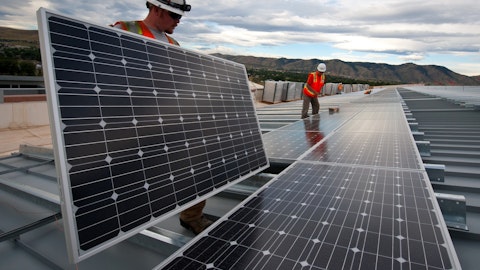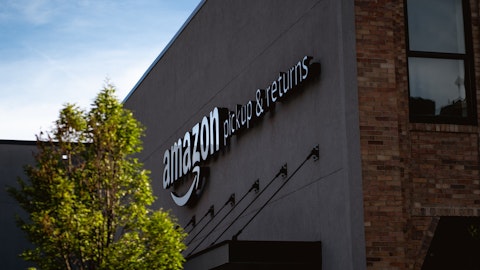Moving forward, we’ll remain opportunistic and potentially further accessing the debt capital markets, ensuring continued strength in our balance sheet, reducing risk and enhancing our financial flexibility. Turning to Slide 15, and in summary, our diverse portfolio of global communications assets continue to demonstrate resiliency in the face of a challenging macroeconomic backdrop, producing attractive growth through organic leasing, further amplified by exceptional cost management at the margin. Complementing our operational performance, we continue to make progress in strengthening and de-risking our balance sheet. Furthermore, we remain committed to managing our capital structure, sources and uses and capital allocation priorities in a manner that positions American Tower to drive sustained attractive returns for our shareholders over the long term.
With that, operator, we can open the line for questions.
Operator: Thank you. [Operator Instructions] And we’ll go to the line of Simon Flannery with Morgan Stanley.
Simon Flannery: Tom, all the best for the future. It’s been great working with you over the years, even back to the Verizon use of cell days. And Steve, congratulations and best of luck in the new role. If we could come back to the capital allocation please. The comments around the dividend and perhaps, Rod, you could just talk about target leverage? Are you thinking about bringing leverage down more aggressively given the rate environment and the uncertain macro environment? Just any color around that would be great or any other drivers of the dividend decision? And perhaps how are you thinking about M&A more broadly outside of the India process that you referenced earlier. There’s a big gap here between public and private markets. Any opportunities there that you see? And what about buybacks? Is that something that could come into your toolbox in the coming quarters here? Thank you.
Rod Smith: Yeah. Simon, good morning. Thanks for joining. I’ll hit the leverage piece first, and then Tom will address the dividend more broadly. When you think about the leverage, we’ve been a little bit higher than our stated range. We’ve been up in the 5, 3 range. We did end this quarter at around 5.0 that was benefited from some non-recurring one-time revenue items. So we do expect that to tick back up towards the end of this year. And we expect to end this year, again, higher than our stated range of 3 to 5 times up in the 5.2%, 5.3% range. It is a priority of ours to bring that leverage down, along with driving organic growth operational efficiency, expanding margins, controlling the SG&A in the — and ultimately, the AFFO and AFFO growth that we can drive.
So the target is to get to 5.0 as soon as we can. We’ll be working through that diligently next year. And a lot of these operational objectives around organic growth and driving AFFO as well as capital allocation, our capital plan, specifically you’ll see a reduction — you’ve seen a reduction in our capital plans this year versus last year. And that, again, is all in line with trying to drive down leverage and strengthen our balance sheet. We do think those are important steps to take to drive total shareholder return in the short term and the long term. So that’s what it’s really all about the dividend holding it flat next year is in line with that. I mean, I’ll say, we believe that’s the best use of capital in terms of strengthening the balance sheet in this time of uncertain rates.
When it comes to M&A, we continue to not see compelling M&A opportunities in our pipeline. So it’s not something that’s hitting our radar screen in terms of capital allocation this year and we turn the corner into next year. Then I’ll turn it over to Tom to hit and a little bit more directly.
Tom Bartlett: First of all, Simon, thanks for your kind words. But maybe with regards to the dividend, it’s important just to just take a step back and understand how we really manage this dividend growth. Since we became a REIT over a decade ago back in 2012, we’ve always looked to complement AFFO growth with a compelling yield, which we’ve grown, as you all know, around 20% annually as compared to our AFFO per share growth, which has been closer to 10% over that same time period. We’ve aligned our distribution with REIT taxable income, as you would expect. And within REIT AI you do have a recurring run rate and more of one-time buckets, consistent of things like earnings and profits, settlements, throwbacks NOLs, which we used last decade, much of which is discretionary in the planning that are absolutely separate from AFFO.
And these tools allow us for to manage a more predictable glide path on our dividend. So here we are in 2023, we’re committed to a 10% dividend growth rate which, like other years, consisted of certain one-time items to manage the dividend path and ensure alignment between our distribution and REIT AI. And so although our recurring REIT AI bucket was negatively impacted by interest rates, we utilize certain one-time items to manage towards the distribution. And absent those items, like most years, we’d be overdistributed. So as we look ahead to ’24, we see an opportunity to accelerate our glide path and reset REIT AI closer to the run rate, which means temporarily relatively flat dividends per share in ’24 decoupled from our expectations for AFFO growth based on our line of sight today.
So our priorities that Rod just laid out really remain on maximizing our total shareholder returns. And we see the optimal path to do so, really centered around strengthening and de-risking our balance sheet, which means, in part, reducing our debt balance and advancing our pathway to sub 5 times net leverage and with that, more financial flexibility. And we view the levers to accelerate this path through maximizing organic growth, reducing our cost base as we’ve done in ’23 and will continue to do in ’24 with disciplined capital allocation that Rod just referred to, together with managing the dividend in a relatively flat basis before resuming growth in line with our recurring REIT AI thereafter. So this isn’t a decision we take lightly, as you would expect.
But given the current macro volatility, we believe that the balance sheet strength and accelerating financial flexibility for future opportunities, which could include buybacks is the optimal approach from where we sit today. So hopefully, that gives you a little bit of a sense, at least in terms of how we’re thinking about it and how it fits into our overall plans for creating value long term.
Simon Flannery: Right. Yeah. That’s very helpful. So just to be clear, the hope would be to resume dividend growth in ’25 or into 25?
Tom Bartlett: Yes.
Simon Flannery: Great. Thank a lot.
Operator: And next, we go to Michael Rollins with Citi. Please go ahead.
Michael Rollins: Thank and good morning. And Tom, I also want to express my thanks and best wishes for your upcoming retirement. Congratulations to Steve on your upcoming transition to the CEO role. Just a couple of questions for me. — You’re welcome. And again, thank you, it’s both at Verizon and at AMP. We’ve been working…
Tom Bartlett: We got a long answer. My hairline has received more than years
Michael Rollins: So a couple of things. So first, on activity levels in the domestic business. Curious, if you could just go deeper into what you’re seeing as you’re looking at the balance of this year and what it means for next year in terms of how that domestic business can grow relative to the long-term annual targets that you set for that business? And if you can — within that context, also unpack the delays that you’re seeing in Sprint related churn and what that means for that decommissioning pace as we look forward? Thanks.





